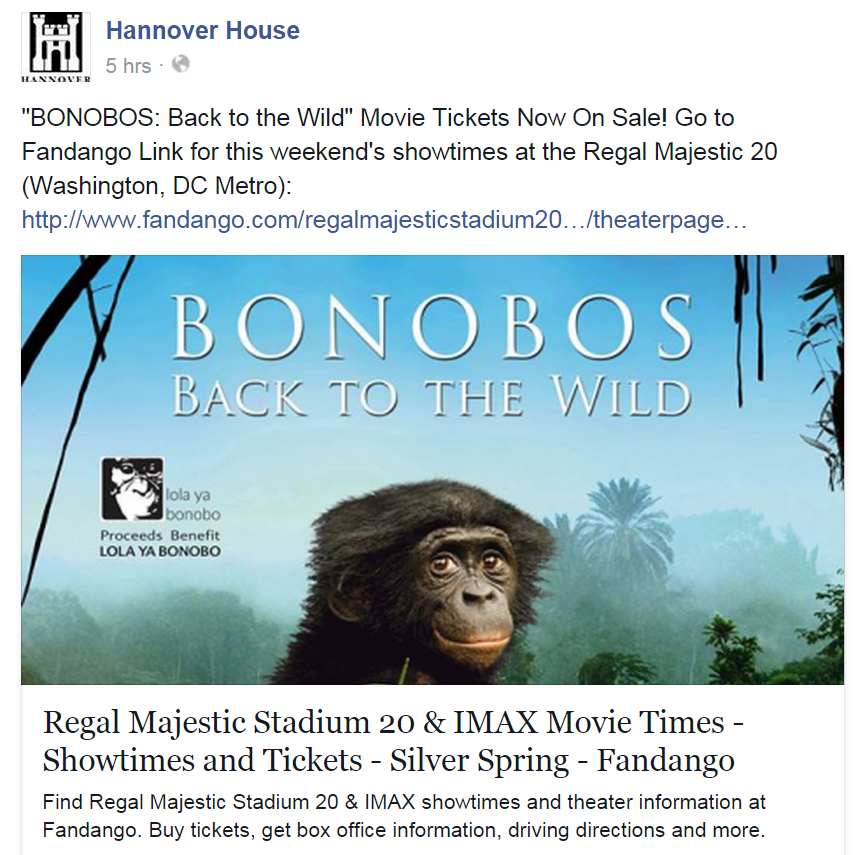| Followers | 130 |
| Posts | 18112 |
| Boards Moderated | 0 |
| Alias Born | 01/16/2007 |
Friday, July 31, 2015 1:04:09 PM


THE WALL STREET JOURNAL
Film Portrays a Bonobo’s Rescue
‘Bonobos: Back to the Wild’ tells the story of Beni, a bonobo captured by poachers, then rescued and raised in a sanctuary before being released to the wild
By MARK ARMAO
July 30, 2015
A primate with a penchant for sex is headed to the big screen in a family-friendly role. A feature-length film opening Friday offers an untraditional portrait of the bonobo, an endangered species that shares more than 98% of its genetic makeup with humans.
Mixing documentary-style footage of bonobos in the forest with staged scenes—even narration from an ape’s perspective—“Bonobos: Back to the Wild” follows the life of Beni, a bonobo captured by poachers and then rescued and raised in a sanctuary before being released to the wild.
The movie, directed by Alain Tixier, takes place mostly in Lola Ya Bonobo, a sanctuary in the Democratic Republic of the Congo run by Claudine André.
Ms. André, who was born in Belgium and raised in Central Africa, came upon her first bonobo in 1993. At the time, she was working to restore a dilapidated zoo in Kinshasa, the Congolese capital, which had been racked by widespread rioting. The sickly infant Ms. André encountered wasn’t expected to survive without his mother.
“The director of the zoo said ‘Don’t put your heart in this animal…He’s an orphan bonobo. They never survive in captivity,’” Ms. André said.
She carried the animal everywhere and within weeks, his condition improved. From that point on, Ms. André devoted herself to preserving the bonobo, one of several species sought by poachers for food.
“Bonobos: Back to the Wild” is about a fictional bonobo, Beni, who is separated from his family. In the film, his mother is shot by poachers and Beni is sold to a bar, where he is kept in a cage and fed beer by patrons. Local authorities help Ms. André rescue him.
The orphaned animal adapts to life among other bonobos at Ms. André’s sanctuary, Lola Ya Bonobo. As Beni grows, he is portrayed by an ensemble of simians. Because bonobos age at a pace similar to humans, the filmmakers used four different animals to represent the various stages of his development. For insights into Beni’s life, the animal’s imagined thoughts are expressed in voice-overs by Welsh actor Luke Evans.
The decision to give a bonobo a human voice flies in the face of traditional wildlife documentaries, where creators tend to favor scientific accuracy over talking apes. But the dramatization of Beni’s story makes audience confusion unlikely, said Chris Palmer, director of the Center for Environmental Filmmaking at American University in Washington.
The filmmakers “are not positioning it as a rigorous science-based documentary, they’re positioning it as a story based on real facts,” Mr. Palmer said. “As long as people don’t leave the theater thinking that bonobos can talk—which I don’t think anyone would—then I think it’s fine.”
To appeal to all ages, the French distributors decided not to show any sex in the movie—an omission that may perplex viewers familiar with the species.
“Sex for bonobos is like a language,” said Ms. André, noting that bonobos have sex throughout the day in part to keep the peace within their female-run society.
In addition to “Bonobos: Back to the Wild,” Mr. Tixier made a more traditional nature documentary about bonobos living with minimal human interaction. A director’s cut of sorts, the 52-minute film includes more than 20 minutes of sex scenes, Mr. Tixier said. Titled “Au Pays des Bonobos” (Land of the Bonobos), the documentary aired on French television in 2011.
The feature about Beni, which came out in France in 2011, will be released with a new soundtrack in English, replacing the original French one. The film opens in Washington and will roll out in 20 markets across the U.S. throughout August. The goal is to entertain while explaining the bonobos’ risk of extinction.
“Conservation begins with education,” Ms. André said. “If you know, you love. And if you love, you protect.”
http://www.wsj.com/articles/film-portrays-a-bonobos-rescue-1438286862

HHSE
Recent HHSE News
- Form 8-K - Current report • Edgar (US Regulatory) • 01/05/2024 07:17:02 PM
FEATURED Cannabix's Breath Logix Alcohol Device Delivers Positive Impact to Private Monitoring Agency in Montana, USA • Apr 25, 2024 8:52 AM
Bantec Reports an Over 50 Percent Increase in Sales and Profits in Q1 2024 from Q1 2023 • BANT • Apr 25, 2024 10:00 AM
Kona Gold Beverages, Inc. Announces Name Change to NuVibe, Inc. and Initiation of Ticker Symbol Application Process • KGKG • Apr 25, 2024 8:30 AM
Axis Technologies Group and Carbonis Forge Ahead with New Digital Carbon Credit Technology • AXTG • Apr 24, 2024 3:00 AM
North Bay Resources Announces Successful Equipment Test at Bishop Gold Mill, Inyo County, California • NBRI • Apr 23, 2024 9:41 AM
Epazz, Inc.: CryObo, Inc. solar Bitcoin operations will issue tokens • EPAZ • Apr 23, 2024 9:20 AM









